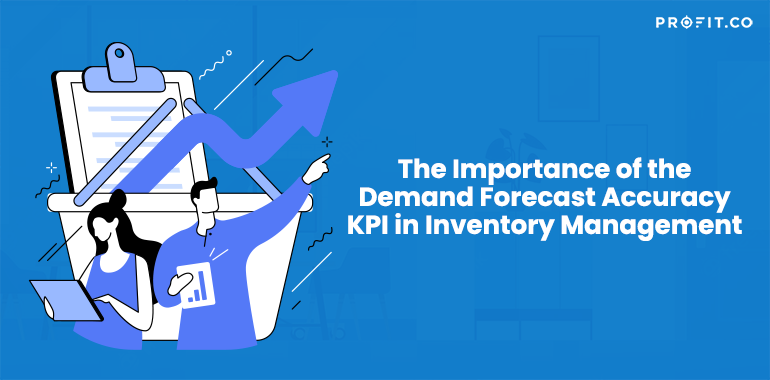Introduction
In the dynamic and competitive business landscape, accurately predicting customer demand profoundly impacts an organization’s success. According to a survey conducted by Forbes, 85% of brands shared they have blind spots within their supply chains, causing customer demand issues.
The most popular Demand Planning KPIs include forecast accuracy, forecast bias, Mean Absolute Percentage Error (MAPE), inventory turnover, and stockout rate. Whether managing inventory levels, production planning, or ensuring exceptional customer service, understanding, and forecasting demand is pivotal in driving efficient operations and maintaining a competitive edge. Here is where the Demand Forecast Accuracy (DFA) Key Performance Indicator (KPI) comes into play.
This blog explores the significance of the Demand Forecast Accuracy KPI and its role in shaping business success. Let’s look into the intricacies of demand forecasting, analyzing the accuracy of forecasts and their impact on operational efficiency, customer satisfaction, and overall profitability.
What is the Demand Forecast Accuracy?
Demand Forecast Accuracy (DFA) is a Key Performance Indicator (KPI) used to measure the accuracy of forecasting customer demand for products or services. It quantifies the extent to which actual demand aligns with the forecasted demand.
Calculation
The Demand Forecast Accuracy KPI is typically expressed as a percentage or an error rate and can be calculated using various methods, such as Mean Absolute Percentage Error (MAPE), Mean Absolute Deviation (MAD), or Root Mean Square Error (RMSE).
Formula

Example
For example, if the actual demand for a product is 100 units, and the forecasted demand is 90 units, the Demand Forecast Accuracy would be (1 – ((100 – 90) / 100)) x 100 = 90%.
Demand Forecast Accuracy = (1 – ((100 – 90) / 100)) x 100 = 90%
The Demand Forecast Accuracy KPI is essential for organizations to evaluate the effectiveness of their forecasting methods and make informed decisions regarding production, inventory management, and supply chain planning. A higher forecast accuracy indicates that the organization better understands customer demand patterns, enabling them to optimize inventory levels, reduce stockouts, and enhance customer satisfaction.
To unlock the full potential of your business and start measuring your KPIs
The Importance of Demand Forecast Accuracy
Optimal inventory management
Accurate demand forecasting helps businesses optimize inventory levels by aligning supply with anticipated demand. A high level of demand forecast accuracy enables organizations to maintain optimal stock levels, reducing the risk of excess inventory or stockouts and improving the inventory turnover ratio. Optimal inventory management leads to cost savings, efficient warehouse management, and improved cash flow.
Enhanced customer satisfaction
Reliable demand forecasts contribute to better customer service and satisfaction. When businesses accurately anticipate customer demand, they can ensure the availability of products or services when needed. Enhanced customer satisfaction leads to improved order fulfillment rates, reduced back orders, and a positive customer experience.
Efficient production planning
Demand forecast accuracy aids in efficient production planning. When businesses can forecast demand accurately, they can plan production schedules, resource allocation, and procurement activities accordingly. Efficient production planning minimizes production delays, avoids underutilization or overutilization of resources, and streamlines overall operations.
Focusing on the customer makes a company more resilient.
Top Strategies for Navigating Demand Forecast Accuracy
Collaborative forecasting
Involve vital stakeholders in forecasting, including sales teams, marketing, and supply chain personnel. Leverage their insights, market knowledge, and customer feedback to enhance the accuracy of demand forecasts.
Market research and customer insights
Conducting market research to understand customer preferences, buying behavior, and anticipated demand is an excellent strategy for navigating Demand Forecast Accuracy. Incorporating these findings into demand forecasting models improves accuracy.
Technology and advanced analytics
One way to navigate Demand Forecast Accuracy is by leveraging advanced forecasting tools and technologies like demand planning software, predictive analytics, and machine learning algorithms. These technologies can help analyze large volumes of data, identify patterns, and generate accurate procurement forecasting.
OKRs are an Effective Solution to Demand Forecast Accuracy
The OKR Framework is a goal management system used by teams to collaborate and achieve stretch goals through a framework that requires regular check-ins, feedback, continuous learning, collaboration, and problem-solving.
OKRs are simple yet powerful, as they are helpful for startups and large corporations to execute their strategy with focus and alignment.
Let’s look at an OKR example using the Demand Forecast Accuracy KPI.
OKR Example
Objective: Improve Demand Forecast Accuracy
Key Result 1: Increase demand forecast accuracy from 70% to 90% within the next quarter
Initiative: Enhance data analysis techniques, leverage advanced forecasting tools and technologies, and incorporate market research and customer insights into the forecasting process to improve demand forecast accuracy.
Key Result 2: Reduce Mean Absolute Percentage Error (MAPE) from 30% to 15% within the next quarter
Initiative: Refine forecasting models, implement demand sensing techniques, and regularly validate forecasts against actual sales and demand data to reduce forecasting errors and improve accuracy.
Key Result 3: Increase cross-functional collaboration rating from 2 to 4 for Demand Forecasting
Initiative: Foster collaboration among sales, marketing, supply chain, and finance teams, establish regular forecasting meetings, and promote knowledge sharing to enhance the accuracy of demand forecasts.
3 Tips for Monitoring Demand Forecast Accuracy
1. Define clear metrics
An excellent method to monitor Demand Forecast Accuracy is establishing additional clear and specific KPIs and metrics for measuring forecast accuracy. Typical metrics include Mean Absolute Percentage Error (MAPE), Mean Absolute Deviation (MAD), or Root Mean Square Error (RMSE). When you clearly define how these metrics are calculated, you can ensure consistency in their application and success.
2. Set realistic targets
One way to monitor Demand Forecast Accuracy is to set achievable targets for demand forecast accuracy based on historical performance, industry benchmarks, and the organization’s specific goals. These targets should be challenging yet realistic to drive continuous improvement for your organization.
3. Regular monitoring
Tracking Demand Forecast Accuracy regularly, such as monthly or quarterly, helps your organization stay on top of the KPI and related metrics. Regular monitoring helps identify trends, assess the effectiveness of forecasting models and techniques, and identify areas where forecast accuracy can be improved. If you can spot areas for improvement, your company can continuously improve to meet customer demand.
Conclusion
Monitoring the Demand Forecast Accuracy KPI allows companies to identify areas for improvement, such as refining forecasting models, enhancing data collection and analysis processes, and improving collaboration between sales, marketing, and operations teams. By continually striving to improve forecast accuracy, organizations can strengthen their supply chain efficiency, reduce costs, and make more accurate strategic decisions.

